A Step-by-Step Guide to Enterprise Chatbots for Businesses

Choosing the right enterprise chatbots can transform your company’s customer service. With the right chatbot, your company can streamline support, boost satisfaction, and cut costs. Many companies now use chatbot solutions to automate up to 80% of FAQs, reduce client costs by 30%, and resolve complaints faster. The chart below shows how enterprise chatbots improve service efficiency and satisfaction.
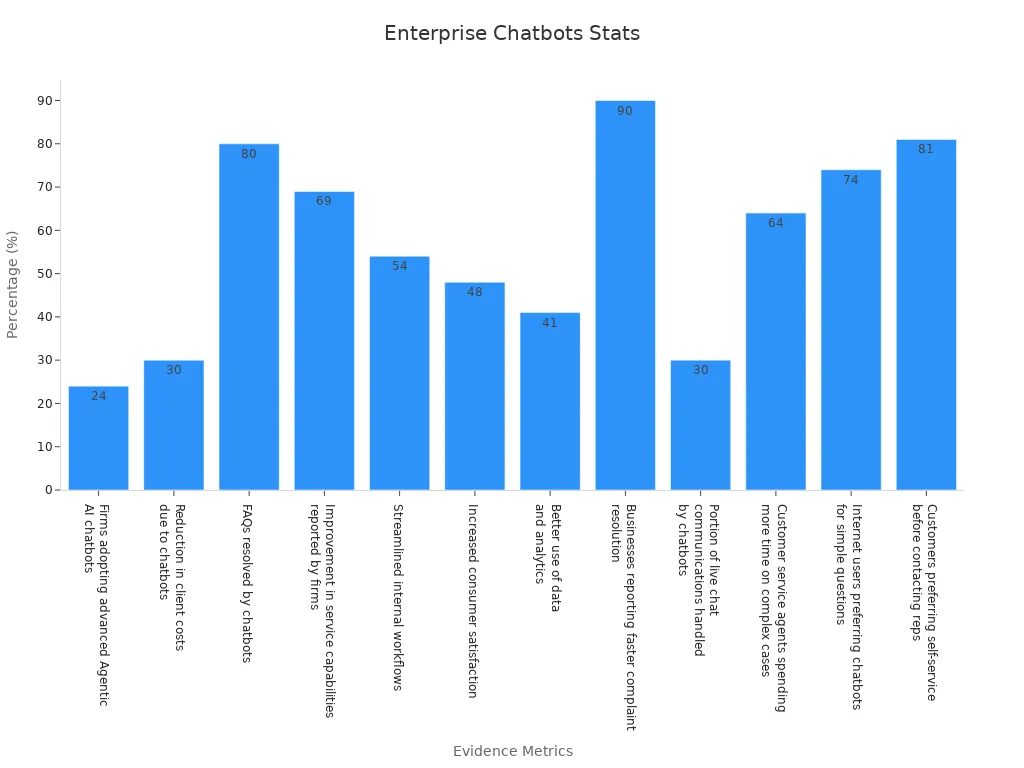
You want a chatbot that fits your business goals, enhances experience, and integrates with your systems. Sobot, a leader in AI-powered solutions, helps companies like yours deliver seamless service across channels. Sobot AI empowers your team to focus on complex needs while the chatbot manages routine tasks.
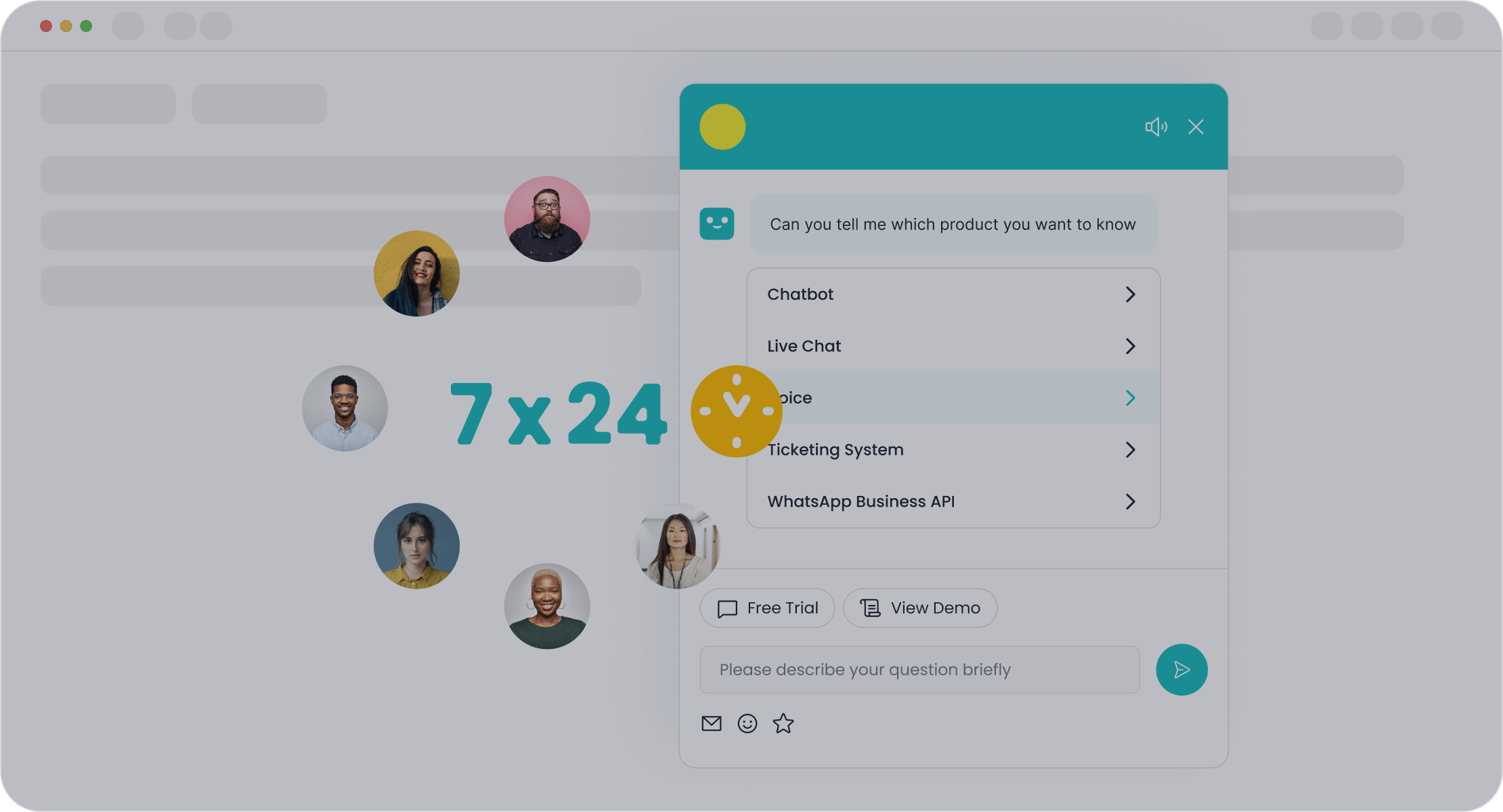
Define Goals and Use Cases
Before you implement enterprise chatbots, you need to decide on the purpose behind your investment. A clear purpose helps you align technology with your business strategy. When you define your customers and their needs, you can create concrete use cases that deliver measurable results. This approach ensures your chatbot supports your goals, whether you want to improve customer service, drive customer engagement, or reduce costs.
Customer Service Needs
Start by identifying the main challenges your customers face. Do they wait too long for answers? Do they struggle to find information on your website? Many businesses use chatbots to solve these problems. You should decide on the purpose of your chatbot by mapping out the most common customer service pain points.
Tip: List the top five questions your customers ask. These questions often become the first use cases for your chatbot.
A well-designed chatbot can handle routine queries, provide instant answers, and free up your agents for complex issues. For example, Sobot’s AI Chatbot helps companies in retail, finance, and ecommerce resolve up to 80% of routine customer queries. OPPO, a global smart device brand, used Sobot’s chatbot to achieve an 83% resolution rate and a 94% positive feedback rate. This led to a 57% increase in repurchase rates, showing how targeted use cases can transform customer service.
Here’s how customer satisfaction compares across support channels:
| Support Channel | Satisfaction Rate |
|---|---|
| AI-Powered Live Chat (Chatbots) | 87.58% |
| Human Live Chat | 85.8% |
| Email Support | 61% |
| Phone Assistance | 44% |
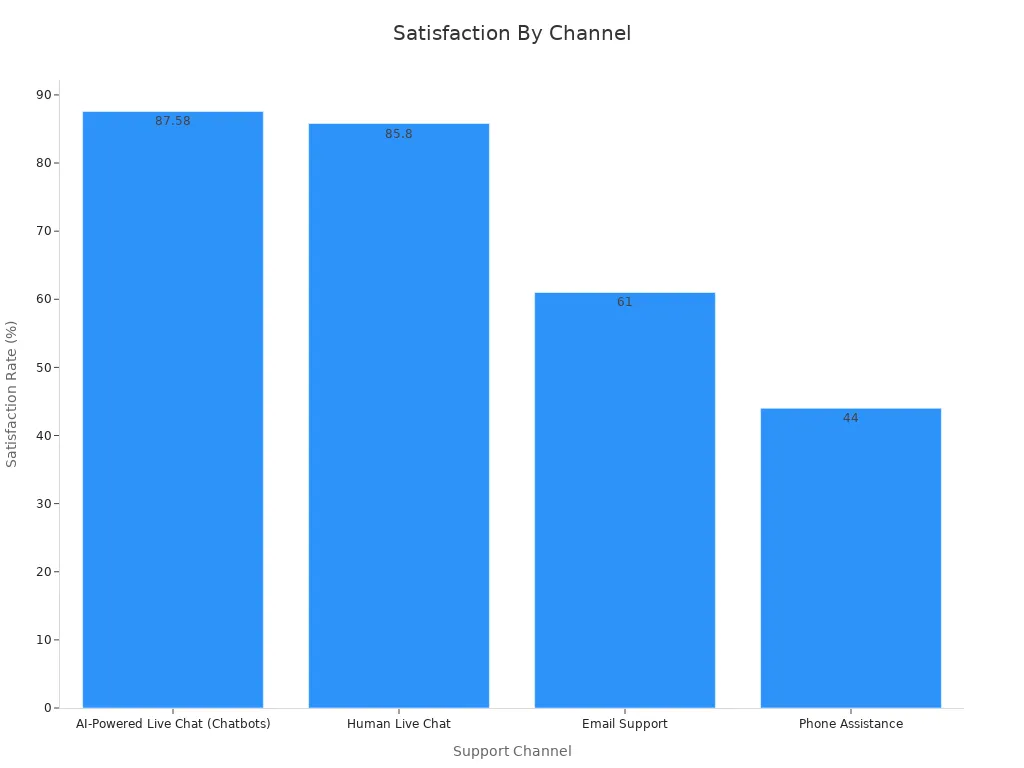
These numbers show that chatbots deliver higher satisfaction than traditional channels. When you define your customers and their expectations, you can create concrete use cases that improve service and boost loyalty.
Business Outcomes
Once you decide on the purpose of your chatbot, you need to connect it to business outcomes. Enterprise chatbots can help you cut costs, generate leads, and increase conversions. You should set clear objectives, such as reducing call volume, improving response times, or increasing sales.
The table below shows how defining business objectives leads to better chatbot performance:
| Statistic / Trend | Description | Relevance to Business Objectives and Chatbot Effectiveness |
|---|---|---|
| Market Growth | Global AI chatbot market valued at $15.6B in 2024, projected to reach $46.6B by 2029 (~24.5% CAGR) | Strong demand driven by efficiency and customer service goals |
| Enterprise Adoption | 80% of sales and marketing leaders have implemented or plan to implement chatbots | Chatbots seen as strategic tools aligned with business goals |
| Customer Handling Efficiency | 90% of customer inquiries handled without human handoff after chatbot deployment | Operational efficiency gains when chatbots automate routine tasks |
| Conversion Improvement | AI chatbots can increase conversion rates by 23% | Improved business outcomes (ROI) when chatbots align with sales and marketing objectives |
| Cost Savings | Up to 30% cost reduction reported | Financial benefits tied to strategic chatbot use |
| Customer Preference | 74–82% of younger customers prefer chat or messaging over calls | Objectives around customer experience and channel preferences enhance chatbot effectiveness |
| Human Assistance Role | 88% prefer human help for complex issues | Clear objectives include defining chatbot scope and escalation strategies |
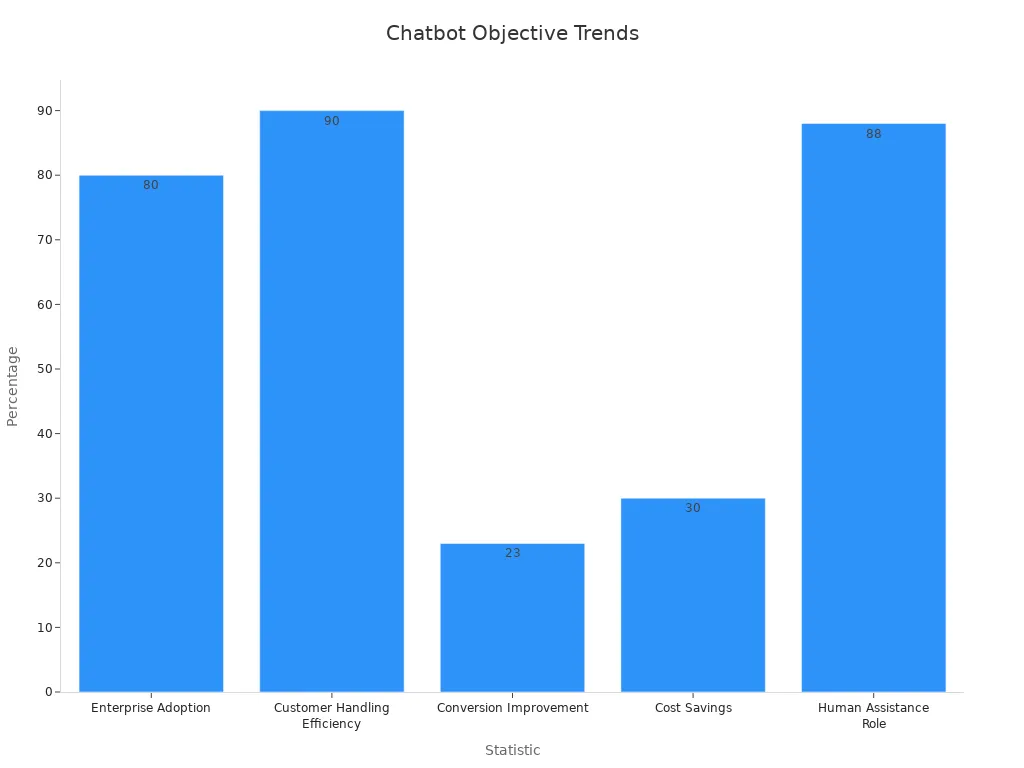
You can see that when you decide on the purpose and align your chatbot with business goals, you achieve better results. Sobot’s AI Chatbot, for example, helps businesses in ecommerce and finance reduce costs by up to 30% and boost conversions by 20%. These outcomes come from creating concrete use cases that match your company’s needs.
Here are some common use cases and their impact:
| Use Case | Description | Numerical Evidence (Cost/Impact) |
|---|---|---|
| Cost Reduction | Chatbots handle repetitive tasks, reduce staff time on queries, and provide 24/7 support. | Enables operational efficiency and cost savings. |
| Lead Generation | Chatbots capture high-quality leads by asking contextually relevant questions. | Implementation cost: $4,000–$8,000; highly ROI-positive. |
| Sales and Conversion | Chatbots assist with pricing inquiries, product recommendations, and appointment bookings. | Cost range: $5,000–$10,000; directly improves conversion rates and revenue. |
Note: In retail and ecommerce, 83% of online shoppers are more likely to complete purchases with chatbot assistance. In finance, AI chatbots are expected to save banks $7.3 billion globally by 2025.
When you create concrete use cases, you unlock the full value of enterprise chatbots. Sobot’s solutions help you automate customer support, capture more leads, and improve engagement across channels. By focusing on your purpose and defining your customers, you set the stage for measurable business success.
Enterprise Chatbots vs. Other Types
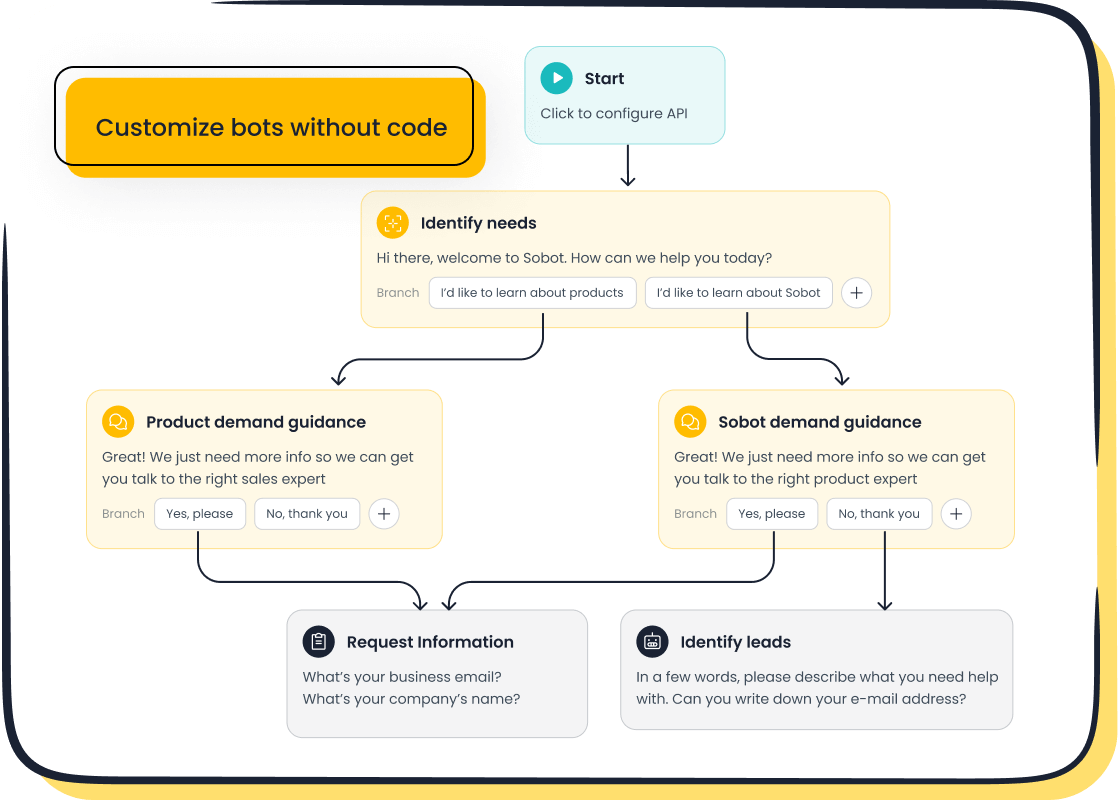
Key Differences
When you compare enterprise chatbots to regular chatbots, you see clear differences in scale, security, and integration. Enterprise chatbots support your company as it grows. They handle large volumes of customer questions across many channels, such as chat, email, and social media. Regular chatbots often work on a single channel and serve fewer users.
Here is a table that shows how enterprise chatbots stand out:
| Feature | Regular Chatbots | Enterprise Chatbots |
|---|---|---|
| Scalability | Single-channel, limited users | Multi-channel, global deployment, automatic scaling |
| Security | Basic encryption | Role-based controls, audit logs, advanced protection |
| Integration | Basic website or app | Deep CRM, ERP, and business system integration |
| Availability | Limited hours | 24/7, no capacity limits |
Enterprise chatbots, like the Sobot AI chatbot, resolve up to 80% of routine customer queries. This leads to 30-40% cost savings and 80% faster response times. You also get advanced security, such as data encryption and audit trails, which protect your company’s sensitive information. Sobot’s best ai chatbot supports global deployment and strict compliance, making it ideal for companies with high standards.
Note: Enterprise ai chatbots offer self-hosted options, keeping your data inside your company’s firewall. This ensures compliance with regulations like GDPR and HIPAA.
When to Choose Enterprise
You should choose enterprise chatbots when your company needs to manage high volumes of customer interactions or requires strict data security. If your business operates in multiple countries or across many channels, the best ai chatbot will help you scale without hiring more staff. Enterprise chatbots also fit companies that need deep integration with CRM or ERP systems.
Consider these points:
- Your company handles thousands of customer questions daily.
- You need 24/7 support with no downtime.
- You must protect customer data and meet strict compliance rules.
- You want to automate workflows and connect with business tools.
Sobot’s ai chatbot gives your company these advantages. It tracks every interaction, supports multiple languages, and adapts to your business needs. With Sobot, you get the best ai chatbot for operational efficiency and customer satisfaction.
Key Features to Look For
AI Chatbot Capabilities
When you evaluate an ai chatbot, focus on the capabilities that drive real results. The best ai chatbot responds quickly, keeps users engaged, and solves problems efficiently. You want a solution that handles up to 80% of routine inquiries, reduces resolution time by 50%, and delivers 37% faster first responses. Sobot’s ai chatbot achieves these benchmarks, helping you boost agent productivity and customer satisfaction.
Key performance metrics include:
- Average response time: Fast replies improve user experience.
- Retention rate: High rates show users return for more help.
- Interaction rate: More messages per session mean deeper engagement.
- Engaged conversations: Quality interactions go beyond greetings.
- Missed messages: Fewer missed queries mean better coverage.
- Bounce rate: Low rates indicate users find value and stay.
| Performance Metric | Statistic / Impact |
|---|---|
| Handling routine tasks | AI chatbots manage up to 80% of routine inquiries |
| Reduction in resolution time | Up to 50% reduction |
| Positive customer feedback | Around 80% positive experiences |
| Agent productivity improvement | 15% more issues resolved per hour |
| Personalization impact on revenue | Up to 15% revenue increase |
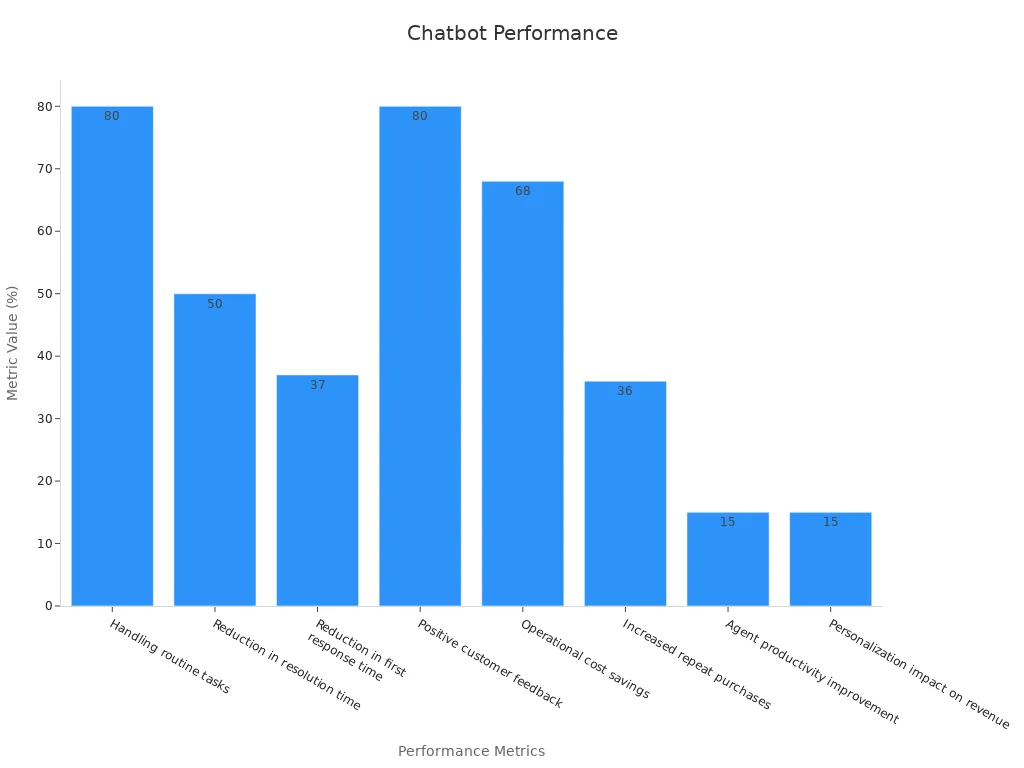
Multichannel Support
You need an ai chatbot that works across all your channels. When you choose the channels of interaction, you reach customers where they prefer to connect—on your website, mobile app, WhatsApp, or SMS. Sobot’s ai chatbot offers true omnichannel support, letting you manage conversations from one unified dashboard.
A strong multichannel ai chatbot delivers:
- Up to 90% automation for FAQs and 60% for transactional queries.
- High retention rates, showing users return for support.
- Low abandonment rates, meaning users get answers before leaving.
- Confidence rates over 70%, proving accurate responses.
| Metric Name | Description | Example/Insight |
|---|---|---|
| Automation Rate | Percentage of interactions handled automatically by the chatbot versus by a human agent. | Up to 90% automation in FAQs, 60% in transactional queries, 75% in service sign-ups. |
| Retention Rates | Percentage of users returning to use the chatbot over time. | Stable or high retention suggests positive user experience. |
| Customer Satisfaction (CSAT) | Measures user satisfaction with chatbot interactions. | High CSAT scores reflect positive customer experience. |
Tip: Choose the channels of interaction that match your customers’ habits to maximize engagement and efficiency.
Security and Compliance
Security and compliance are critical when you deploy customer support chatbots. You must protect sensitive data and follow regulations like GDPR and HIPAA. Sobot’s ai chatbot uses encryption protocols, role-based access controls, and regular security audits to keep your data safe.
Key security features include:
- Encryption of data in transit and at rest using HTTPS and SSL/TLS.
- Multi-factor authentication to prevent unauthorized access.
- Continuous monitoring and incident response plans.
- Compliance with global data protection laws.
- Regular penetration testing to identify vulnerabilities.
Enterprise ai chatbot platforms like Sobot ensure your customer support remains secure, compliant, and reliable across all channels.
Integration with Business Systems

CRM and Support Platforms
Seamless integration with your CRM, helpdesk, and ecommerce systems is essential for any enterprise chatbot. When you connect your AI chatbot to these platforms, you unlock real-time data, automate workflows, and deliver a unified customer experience. You can track every interaction, personalize responses, and resolve issues faster.
Sobot’s AI chatbot stands out for its omnichannel integration. You can connect Sobot to your CRM, ticketing, and ecommerce tools, so your team always has the latest customer information. For example, OPPO used Sobot to link global customer channels and business systems. This integration helped OPPO achieve an 83% chatbot resolution rate and a 94% positive feedback rate.
Here’s how integration impacts business outcomes:
| Metric / Outcome | Reported Improvement / Impact | Industry / Example |
|---|---|---|
| Customer satisfaction increase | Up to 25% increase | General enterprise chatbot users |
| Operational efficiency improvement | 70-80% of companies report improvements | General enterprise chatbot users |
| Cost reduction | Up to 30% reduction | General enterprise chatbot users |
| Conversion rate increase | 15-20% increase | Retail (e.g., Sephora, Stitch Fix) |
| Cart abandonment reduction | 25% reduction | Retail |
Integrating your customer support chatbot with business systems boosts efficiency, increases satisfaction, and drives revenue.
Data Flow and Privacy
A successful enterprise chatbot must ensure secure, real-time data flow and protect customer privacy. When you integrate your AI chatbot with CRM and support platforms, you enable bidirectional data sync. This keeps customer records up to date and supports seamless handoffs between bots and agents.
Sobot’s customer support chatbot uses encrypted connections and role-based access controls. You can trust Sobot to comply with global standards like GDPR and CCPA. The platform supports secure data flows, automates consent management, and provides audit trails for every interaction.
| Improvement Aspect | Quantifiable Result / Description |
|---|---|
| Customer Service Cost Reduction | Up to 30% reduction in expenses due to high deflection rates. |
| Customer Retention | 35% increase in retention from omnichannel chatbot integration. |
| Data Flow | Real-time sync between chatbots and CRM/ERP systems for up-to-date customer data. |
| Customer Privacy Measures | End-to-end encryption, role-based controls, and PII anonymization. |
- You benefit from:
- Fast, accurate responses with real-time data.
- Secure storage and transmission of sensitive information.
- Automated compliance with privacy regulations.
Sobot’s enterprise chatbot solutions help you build trust, improve efficiency, and keep your customer data safe. Learn more about Sobot’s integration capabilities at Sobot AI Chatbot.
Choose the Right Chatbot for Your Customers
Selecting the best chatbot for your business means you must understand your customers and their expectations. You want to design the perfect chatbot that reflects your brand, creates a happy flow of conversation, and delivers a seamless user experience. When you choose the right chatbot, you build trust and loyalty, making every interaction count.
Customization and Branding
Your chatbot should look and sound like your brand. Customization goes beyond colors and logos. You need to design the perfect chatbot that speaks your brand’s language, uses the right tone, and adapts to your industry. Customers expect a personalized touch. In fact, 80% of consumers are more likely to buy from brands that offer personalized experiences. More than 70% expect personalization as a standard service. If your chatbot fails to deliver relevant content, 42% of customers feel frustrated.
You can see how industry leaders use customization to drive results:
| Statistic Category | Key Data Points | Implication for Customization and Branding |
|---|---|---|
| Marketing Effectiveness | 55% of companies see increased high-quality leads; conversion rates up to 70%; 67% sales increase | Focus on lead generation and conversion optimization |
| User Engagement Expectations | 73% of buyers expect chatbots on websites; 87.2% rate bot interactions as neutral or positive | Branding should emphasize seamless, positive user experience |
| Industry Adoption & Satisfaction | Tech (73%), Retail (67%), Manufacturing (57%), Healthcare (56%) satisfaction rates | Tailor chatbot features and tone to each industry |
| Deployment Type | Cloud-based chatbots hold 58.4% market share; preferred for scalability and cost-efficiency | Brand around reliability and flexibility |
| Business Function Focus | Sales and marketing hold 39.5% market share; e-commerce & retail 28.7% market share | Prioritize sales enablement and retail customer journeys |
| Sales Impact | 67% sales increase reported; 26% of sales start from bot interaction; 35% credit bots for closing deals | Highlight sales-focused chatbot capabilities |
| Social Media Integration | Chatbots on Facebook, Instagram enable real-time service and personalized marketing | Leverage social media presence and dynamic engagement |
| Market Growth & Size | $4.7B market in 2022; projected 23.3% CAGR to $15.5B by 2028 | Growing investment and innovation opportunities |
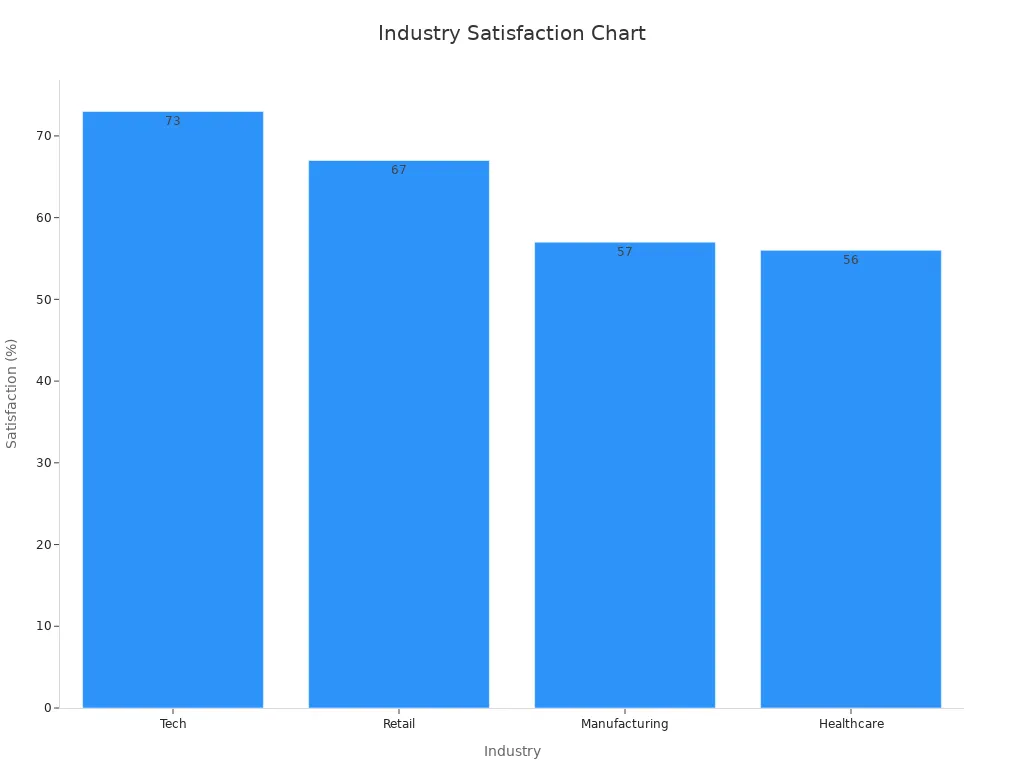
Sobot helps you design the perfect chatbot for your brand. You can customize the chatbot’s appearance, language, and workflow with a simple point-and-click interface. Sobot’s AI chatbot supports multiple languages and channels, so you reach customers wherever they are. You can even create a happy flow of conversation that matches your brand’s personality, whether you work in retail, finance, or e-commerce.
Tip: Personalization drives loyalty. Over 60% of consumers will not repurchase after a poor experience. Make sure your chatbot delivers relevant, timely, and branded responses every time.
User Experience
You must prioritise user experience when you design the perfect chatbot. Customers want fast, clear, and helpful answers. They expect the chatbot to understand their needs and guide them through each step. If you create a happy flow of conversation, you make it easy for customers to get what they want.
Successful companies show how the right chatbot improves user experience:
- Delta Airlines uses a chatbot for real-time flight updates and check-in help, reducing wait times and improving travel.
- H&M’s AI chatbot gives product suggestions and order tracking, boosting engagement and sales.
- Capital One’s Eno chatbot helps with banking tasks, making financial services secure and personal.
- GrandStay Hotels’ chatbot handles 80% of guest requests, freeing staff for complex issues and raising satisfaction scores.
You can measure user experience with clear metrics:
- Effectiveness: Does the chatbot help customers complete their goals?
- User satisfaction: Do customers enjoy the conversation?
- Relevance: Are the chatbot’s replies clear and useful?
- Confidence: Do customers feel more confident after chatting?
- Efficiency: How quickly do customers get answers?
- Transparency: Does the chatbot explain its actions and handle errors well?
- Autonomy: Can customers reset or correct the conversation easily?
Sobot’s AI chatbot uses these metrics to improve every interaction. You get detailed reports and feedback, so you can keep optimizing the chatbot for your customers. Sobot’s platform lets you design the perfect chatbot that adapts to your business and customer needs, ensuring every conversation is smooth and effective.
Note: Positive user experiences with AI chatbots build trust and loyalty. Chatbot engagements can increase revenues by 67%, with 26% of sales starting from a chatbot conversation.
When you choose the right chatbot and prioritise user experience, you set your business up for long-term success. Sobot gives you the tools to design the perfect chatbot, create a happy flow of conversation, and delight your customers at every touchpoint.
Evaluate ROI and Budget
Cost Savings
You want to see real savings when you invest in enterprise chatbots. Many companies report significant reductions in operational expenses after deploying AI chatbots. For example, TechStyle Fashion Group saved $1.1 million in the first year by automating customer support. Chatbots help you cut costs by reducing the need for extra staff, lowering training expenses, and providing 24/7 service without overtime pay. You can also handle more customer inquiries during peak times without hiring more agents.
- Chatbots automate repetitive tasks, so your team can focus on complex issues.
- Smaller contact centers have seen up to 74% profit expansion and 87% less agent effort.
- Companies report up to 92% faster resolution times after chatbot adoption.
Here is a table showing how different organizations benefit from chatbot cost savings:
| Organization / Sector | Cost Reduction / Efficiency Gain | Description / Impact |
|---|---|---|
| Global Software Organization | 40% cost reduction within 6 months | Savings from reduced labor hours and infrastructure expenses after chatbot integration. |
| Gartner Research | Up to 30% operational cost cut | Cost savings by automating repetitive and routine tasks. |
| Leading Bank XYZ | 35% cost saving | Automation of FAQs and transactional requests reduced labor-intensive compliance and interaction. |
| Global Retail Giant (Company ABC) | 60% decrease in customer waiting times; 40% staffing cost reduction | Chatbots managed post-purchase inquiries, warranty claims, and returns, improving efficiency. |
| Multinational Company Y | 30% decline in human-assisted support tickets; 20% customer satisfaction improvement | Chatbot deployment across departments reduced support volume and enhanced satisfaction. |
| IBM Study | Chatbots handle about 80% of routine inquiries | High volume query handling reduces human agent workload and operational costs. |
Sobot’s AI chatbot helps you achieve these savings by automating up to 80% of routine queries and supporting your team around the clock. This approach improves both affordability and roi for your business.
Performance Metrics
To measure the roi of your chatbot investment, you need to track the right performance metrics. Financial savings matter, but you should also look at engagement, conversation quality, and channel effectiveness. ROI grows over time as your chatbot learns and more users adopt it.
| Metric Category | Key Metrics | Business Outcome Measured |
|---|---|---|
| Engagement Metrics | Total interactions, user engagement rate, average conversation length, interaction frequency | Measures user adoption and chatbot usage intensity |
| Conversation Metrics | Goal completion rate, fallback rate, user satisfaction score, conversion rate | Assesses chatbot effectiveness, user experience, and conversion success |
| Channel Metrics | Channel engagement, channel-specific goal completion, channel satisfaction | Identifies best-performing channels and consistent user experience across platforms |
| Cost Metrics | Cost per interaction, cost savings | Evaluates financial impact and cost-effectiveness compared to human support |
You should combine these metrics to get a full picture of your chatbot’s roi. Sobot provides detailed analytics so you can see where your chatbot performs best and where you can improve. This data-driven approach ensures you maximize both affordability and roi as your business grows.
Tip: Track baseline metrics before and after chatbot deployment to see clear improvements in cost, efficiency, and customer satisfaction.
Test, Measure, Improve
Deployment
You want your enterprise chatbot to succeed from day one. Start with a careful rollout and track key metrics to measure early performance. Focus on these important indicators:
- Resolution rate: How many issues the chatbot solves without human help
- First response time: How quickly users get their first reply
- Customer satisfaction (CSAT): How users rate their chatbot experience
- Cost per conversation: The average cost to handle each chat
- User adoption: The percentage of customers or employees using the chatbot
Successful companies often see over 70% resolution rates and CSAT scores above 4.0 within the first 90 days. Use A/B testing to compare different chatbot versions. Monitor metrics like response accuracy, user satisfaction, and handoff frequency. Sobot’s AI chatbot provides detailed analytics, helping you track these numbers in real time.
| Metric Category | Metrics / Test Areas | Target or Criteria |
|---|---|---|
| Engagement | Self-service rate, usage | Aim for ~20% repeat users |
| Performance | Response time, completion | Ensure quick, accurate responses |
| Quality | Bot Experience Score (BES) | Maintain BES at 75 or higher |
| Business Impact | Resolution rate, handoffs | Compare against baseline metrics |
Tip: Review conversation logs to spot trends and improve the chatbot’s replies.
Continuous Optimization
After deployment, keep improving your chatbot. Track metrics like engagement rate, abandon rate, resolution rate, and CSAT. Use feedback from in-chat surveys, follow-up emails, and support ticket reviews. These insights help you spot gaps and refine the chatbot’s performance.
Measure intent coverage to see how well the chatbot understands user needs. Regularly update the knowledge base and conversation flows. Sobot’s platform supports agile updates, so you can adapt quickly as your business grows. Use before-and-after comparisons to show progress and justify new improvements.
- Review analytics weekly to catch issues early.
- Adjust conversation scripts based on user feedback.
- Test new features in small groups before a full rollout.
Continuous optimization ensures your chatbot delivers value and keeps pace with changing customer expectations.
Choosing the right chatbot solutions starts with clear goals and a focus on customer service needs. You align technology with your business strategy and deliver better service every day. Sobot helps you achieve this with advanced tools and seamless integration.
- Global cost savings from enterprise AI chatbots reached $11 billion in 2022.
- Customer service operational costs can drop by up to 80%.
- Some organizations see a 533% ROI in less than a year.
Ongoing evaluation and optimization keep your customer service strong and your business growing.
FAQ
What is an enterprise chatbot and how does it help my business?
An enterprise chatbot is an AI-powered tool that automates customer interactions across channels. You can use it to answer FAQs, handle support, and boost sales. Sobot’s enterprise chatbot helps you cut costs by up to 30% and improve customer satisfaction.
How does Sobot’s AI chatbot integrate with my existing systems?
You can connect Sobot’s AI chatbot with your CRM, helpdesk, and ecommerce platforms. This integration keeps customer data updated in real time. For example, OPPO used Sobot to link global channels and achieved an 83% chatbot resolution rate.
Is a customer support chatbot secure for handling sensitive information?
Yes. Sobot’s customer support chatbot uses encryption, role-based access, and regular security audits. You meet global standards like GDPR. Your customer data stays protected at every step.
Can I customize the enterprise chatbot for my brand?
Absolutely! You can personalize Sobot’s enterprise chatbot with your brand’s language, appearance, and workflow. The point-and-click interface makes customization easy. Over 80% of consumers prefer brands that offer personalized chatbot experiences.
What performance metrics should I track for my AI chatbot?
You should monitor resolution rate, customer satisfaction (CSAT), response time, and cost per conversation. Sobot’s AI chatbot provides detailed analytics. These metrics help you measure ROI and improve your customer support chatbot over time.
Tip: Regularly review your chatbot’s analytics to keep improving performance and customer experience.
See Also
How To Select The Top Chatbot Software Solutions
Simple Steps To Integrate A Chatbot On Your Website
Effortless Ways To Use Chatbot Examples On Websites
